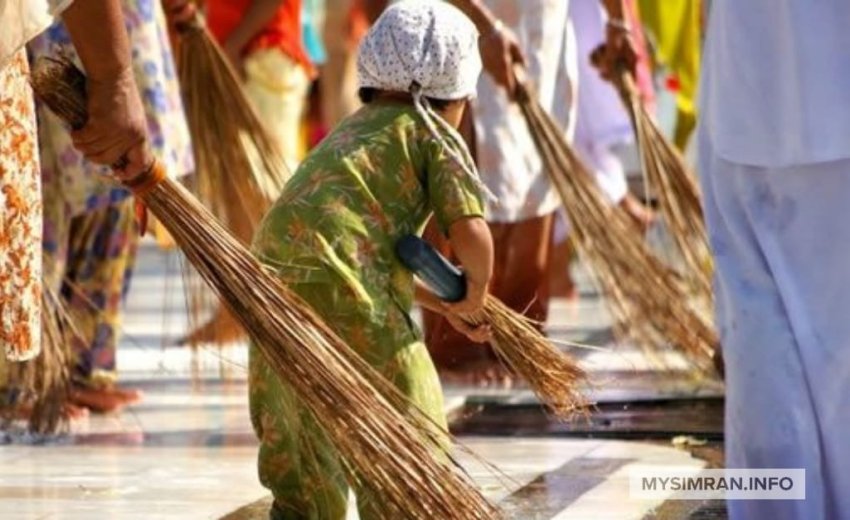“Seva” is a Sanskrit word meaning “selfless service” or work performed without any thought of reward or repayment. A Gursikh does seva to progress in his/her spiritual journey and at the same time to contribute to the community. Often we confuse seva with actions that have the veiled or apparent desire to look noble, big-hearted or nice. Let’s learn the meaning of real seva, how it’s done and why it’s important for a Gursikh.
Who does seva?
We do seva using our physical body so that our mind gets to live in a place where there is no ego, only love for Waheguru. That’s why we go to the gurdwara to do different kinds of seva like langar preparation, jorah ghar, doing kirtan, etc. But the key is to be mindful. How is that possible? By doing Simran when performing seva.
If we’re chatting away while preparing langar, or checking our phones while doing jorah ghar seva, then is the mind really present? The body is surely doing the seva but the mind is focused on other things.
Seva is performed for Waheguru, and the love for Waheguru is the only reason to do seva. This love comes from our dhyaan. If our dhyaan is in Simran then it can be considered as true and real seva. If our dhyaan is in worldly affairs then our body is definitely going through the actions of seva but the mind is absent. Our dhyaan on Waheguru through Simran, along with our body doing the physical actions together makes seva meaningful.
Why do seva?
Seva serves two purposes. One, it nurtures the love for Waheguru and the sangat. This love can help a Gursikh in her/his spiritual journey. Though the sevak has no desire for payback or reward, Waheguru can still bless a Gursikh with the wealth of Naam or the company of sat sangat.
Second, seva contributes to the development of a community by bringing it together. Seva done with a true love for Waheguru can inspire others to do the same. When done with dhyaan, seva creates a hunger for spiritual progression.
How to do seva?
When Mata Ganga Ji went to meet Baba Budha Ji with food prepared by her servants, she was denied entry into his home. Baba Ji refused to see her and accept her offerings. After talking to Guru Arjan Dev Ji, Mata Ganga Ji realized her mistake – preparing langar without dhyaan and by others. Next time, Mata Ji prepared the langar herself while doing Simran. She kneaded the dough with her own hands and chopped vegetables for subjee and lovingly prepared the langar. When she went again, Baba Ji was standing outside the village eagerly waiting for her.
Similarly, our mind or dhyaan should be with Waheguru when performing seva. The food becomes Amrit when Simran is done while preparing food.
ਸੇਵਾ ਸੁਰਤਿ ਸਬਦਿ ਚਿਤੁ ਲਾਏ ॥
Center your awareness on seva-selfless
service-and focus your consciousness
on the Shabad.
Paying for janitorial services to clean the bathroom of a Gurdwara or paying for catering to prepare langar robs us of opportunities to do seva. Automation/machines or hired labor can do things for us but then how or when will we learn to put our dhyaan in the service of Waheguru?
What is not seva?
Getting paid for your actions, or your profession is not seva. Doing nice things with an expectation for a reward into the future is not seva.
For example, my uncle, who is a doctor saves people’s lives. Unfortunately, your uncle is not doing seva – he is doing is a job. Being a doctor is his profession. It’s no different than a lawyer who saves an innocent person from going to jail or a police officer who keeps a neighborhood safe. All these professions or duties are done with a reward or repayment in mind.
In another example, my cousin told me that he likes to buy tea for his night shift staff and he sees it as a seva. He also confessed that he expects his staff to be more productive and motivated as a result of this free incentive. The mere expectation of a reciprocal reward deems his actions to be a transaction and not seva. In contrast, when Guru Nanak Dev Ji spent 20 rupees to feed hungry sadhus and saints, he did it out of love for Waheguru. There was no expectation for anything in return. It was a true seva.
The highest form of seva
When we do Simran it’s to focus and put our dhyaan on the Gurmantar. From our love for Gurmantar, we progress towards loving Waheguru. Ultimately this is the process to help us achieve the purpose of our lives, which is to meet Waheguru while alive.
Through Simran, we merge into Waheguru and liberate ourselves. We can then help our families and fellow Gursikhs to walk on this path so they can also get liberated. Simran has the power to transform individuals, families, and communities. The highest form of seva is to liberate ourselves and help others to become liberated from the cycle of life and death, the cycle of karma.
Seva and Simran go together. Let’s make both integral parts of our lives to win our mind and win the world.


